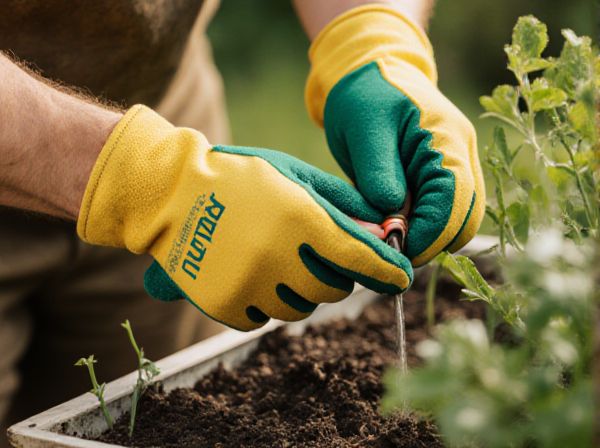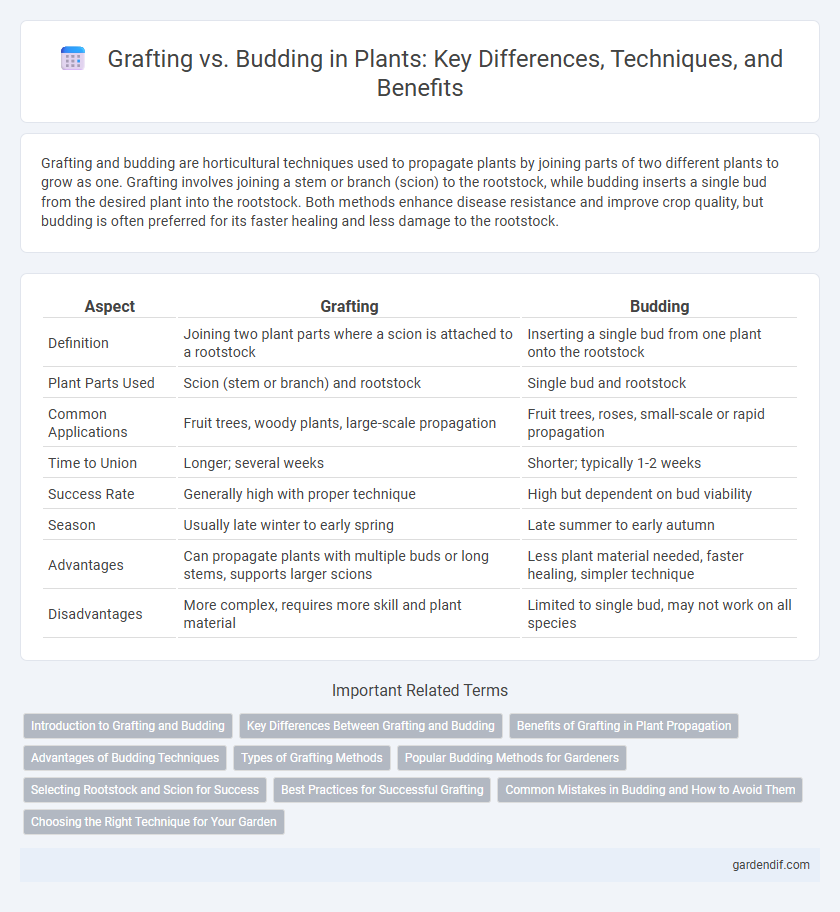
Grafting vs Budding Illustration
Grafting and budding are horticultural techniques used to propagate plants by joining parts of two different plants to grow as one. Grafting involves joining a stem or branch (scion) to the rootstock, while budding inserts a single bud from the desired plant into the rootstock. Both methods enhance disease resistance and improve crop quality, but budding is often preferred for its faster healing and less damage to the rootstock.
Table of Comparison
| Aspect | Grafting | Budding |
|---|---|---|
| Definition | Joining two plant parts where a scion is attached to a rootstock | Inserting a single bud from one plant onto the rootstock |
| Plant Parts Used | Scion (stem or branch) and rootstock | Single bud and rootstock |
| Common Applications | Fruit trees, woody plants, large-scale propagation | Fruit trees, roses, small-scale or rapid propagation |
| Time to Union | Longer; several weeks | Shorter; typically 1-2 weeks |
| Success Rate | Generally high with proper technique | High but dependent on bud viability |
| Season | Usually late winter to early spring | Late summer to early autumn |
| Advantages | Can propagate plants with multiple buds or long stems, supports larger scions | Less plant material needed, faster healing, simpler technique |
| Disadvantages | More complex, requires more skill and plant material | Limited to single bud, may not work on all species |
Introduction to Grafting and Budding
Grafting and budding are essential plant propagation techniques used to combine desirable traits from different plants into a single specimen. Grafting involves joining a scion, a shoot or bud from one plant, onto the rootstock of another, ensuring vascular tissue alignment for nutrient flow. Budding specifically inserts a single bud from the desired plant onto the rootstock, promoting efficient growth and compatibility between species.
Key Differences Between Grafting and Budding
Grafting involves joining a scion and rootstock of different plants to grow as one, while budding uses a single bud from the desired plant inserted into the rootstock. Grafting typically requires mature scions and multiple cuts, whereas budding uses young buds and a single T-shaped cut. Success rates vary as grafting is suited for larger plant parts and woody crops, while budding excels in fruit trees and faster propagation.
Benefits of Grafting in Plant Propagation
Grafting enhances plant propagation by combining the best traits of two plants, resulting in improved disease resistance, increased growth rate, and higher yield. It allows for the production of uniform, true-to-type plants, ensuring consistency in fruit quality and plant characteristics. This method also enables faster maturation compared to budding, accelerating the time to harvest.
Advantages of Budding Techniques
Budding offers higher success rates in propagating fruit trees due to better compatibility between rootstock and bud, leading to faster healing and growth. This technique requires less scion wood and can be performed during a wider range of seasons compared to grafting, making it more efficient for nurseries. Budding also allows for multiple buds to be placed on a single rootstock, increasing the chance of successful propagation and genetic diversity.
Types of Grafting Methods
Grafting methods include whip and tongue, cleft, side veneer, and approach grafting, each tailored for specific plant sizes and compatibility. Whip and tongue grafting is ideal for young, similarly sized plants, promoting strong union and vascular connection. Cleft grafting suits large rootstocks for fruit trees, while side veneer and approach grafting are effective for woody plants and repairing damaged trees.
Popular Budding Methods for Gardeners
Popular budding methods for gardeners include patch budding, T-budding, and chip budding, each offering unique advantages depending on plant type and growth stage. T-budding is widely favored for its simplicity and high success rate on fruit trees like apples and peaches, while chip budding allows more precise control and is ideal for woody shrubs and roses. Patch budding is less common but useful for larger cambium exposure, promoting better union between scion and rootstock.
Selecting Rootstock and Scion for Success
Selecting compatible rootstock and scion is crucial for grafting and budding success, ensuring vascular alignment and nutrient flow. Rootstock should be disease-resistant and adapted to local soil conditions, while the scion must possess desired fruit quality and growth characteristics. Proper matching of growth rates and cambium activity between the two parts enhances union strength and long-term plant health.
Best Practices for Successful Grafting
Successful grafting requires selecting compatible rootstock and scion to ensure vascular tissue alignment for optimal nutrient flow. Maintaining a clean, sharp cutting tool and securing the graft union with appropriate materials like grafting tape or wax minimizes infection and desiccation. Consistent environmental control, including humidity and temperature, promotes callus formation and stronger graft unions in horticultural practice.
Common Mistakes in Budding and How to Avoid Them
Common mistakes in budding include selecting incompatible rootstock and scion, improper timing during active growth phases, and inadequate bud insertion causing poor union formation. Avoid these errors by ensuring genetic compatibility, performing budding in late summer when sap flow is optimal, and carefully matching cambial layers for successful bud adherence. Proper sanitation and moisture control also prevent infections and desiccation, enhancing bud survival rates.
Choosing the Right Technique for Your Garden
Grafting is ideal for combining two mature plants to improve disease resistance and increase fruit yield, while budding is better suited for propagating new plants from a single bud, offering faster growth in small spaces. Consider the plant species and your garden's climate when choosing, as grafting works well with woody plants and budding suits fruit trees and roses. Proper timing in the growing season enhances success rates for both techniques, ensuring healthy and vigorous plant development.
Grafting vs Budding Infographic

 gardendif.com
gardendif.com